|
— Each holy Hebrew letter is hand written as
though it were hanging from a horizontal scored line -
the light grey dashed lines to the right and left at the
top of this letter. · The horizontal top of a letter - if there is one - is called "the roof" of the letter. · The vertical appendage(s) of a letter - again if there is one - is called "a leg." · This letter is a tsadik * (also spelled tzadik, tsadi, tsade, or sade in English) - TSAH dee(k). It has two "heads" rather than a roof. Both heads, though, hang from the scored line. · Usually, the "head" of a letter is square. One corner of the right-side head of the letter tsadik is rounded, though. · I drew curved lines from points (a), (b), (c) and (d) toward features of this letter. These curved lines are not part of the letter at all, though. · I labeled the points (a), (b), (c) and (d) from right to left just as Hebrew is written and read. · Three tagin (TAH gheen), "crown points," * adorn the left head of this letter (b, c & d) (above). Tagin, these embellishments, extend above the roof or head of a letter. In my way of thinking, a tag (TAHG, singular) looks like a finger with an exaggerated finger pad. * · Some letters, such as this tsadik, have three crown points. · Some letters have only one, and some letters have none. · Also, the top right corner of this letter's head points up and out (a) (above). We call this a "thorn." The thorn also extends slightly above the roof or head of a letter. · Some letters have a thorn pointing up and out from the letter's left head or even pointing down instead. · Some letters have no thorn at all. · Some letters have no crown points either. · The smallest detail of each letter is essential (usually). If a letter is supposed to have a thorn but the thorn is found missing, a scribe inks in the thorn. · If a crown point is missing, a scribe adds it. · If a letter is not hanging from the scored line, a scribe erases the letter and writes it hanging correctly. · Many Hebrew letters are supposed to fill out to the size of a square — excluding any thorns or crown points. I've inserted light grey dashed lines at the top and bottom of my first drawing. This rendering of the tsadik is not square and may not pass muster. · The Hebrew letter yod (YOOD, rhyming with the English words 'wood' or 'hood') has one crown point. It also has a thorn pointing down. · The letter nun (NOON, with the same vowel sound as the 'oo' of the English word 'wood') has three crown points adorning its head. · We read and write Hebrew from right to left. A letter faces left toward the next letter. This side of a letter is called its "face." The other side is called its "back." · The letter tsadik is a composite letter. The letter yod (YOOD, rhyming with the English words 'wood' or 'hood') is attached to the letter nun (NOON, with the same vowel sound as the 'oo' of the English word 'wood'). · In writing the tsadik, its letter yod is inverted and the yod's bottom is squared, so the yod loses its thorn which points down. · Also, the yod's short leg is bent backward to connect to the nun. · The nun leans forward in the letter tsadik to accommodate the attached yod. · Neither the letter nun nor the letter yod by themselves fill a square. In fact, they are not supposed to. However, the letter tsadik, as a composite, does fill a square like many (or most) Hebrew letters. · This form of the letter tsadik is also called 'tsadik kefufa' and, to review, consists of pieces from two different letters. The left part is a 'nun kefufa', which is even more curved than a nun normally is, and it has a wider bottom base than normal. The right part is a reversed yod, which is resting on the back part of the nun. The left head has three tagin, crown points, on it, like a regular nun. The heads should not touch one another at all. · (The overall size should be 3 x 3 kulmusim.) kefufa - k' foo FAH; Kefufa means compact or bent around, in contrast to the elongated form of a letter (final tsadik, 'tsadik sofit'; or final nun, 'nun sofit'). In the context of being a composite letter, kefufa also means bent forward. nun kefufa - נ; elongated nun - ן (in a modern font, which is only used for secular or profane [not holy] purposes) tsadik kefufa - צ; elongated tsadik - ץ (in a modern font, which is only used for secular or profane [not holy] purposes) kulmusim - kuhl MOO sihm; nibs of a feather pen
|
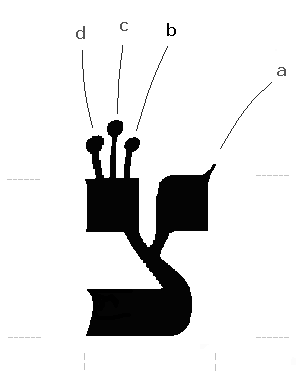
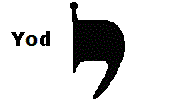
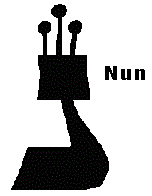
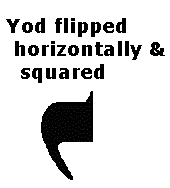
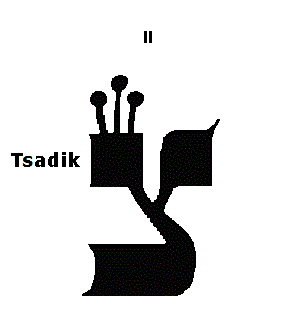
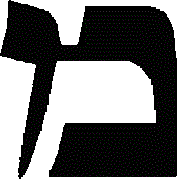 Notice that this letter, the letter mem, precedes the letter tsadik when they describe the
Notice that this letter, the letter mem, precedes the letter tsadik when they describe the